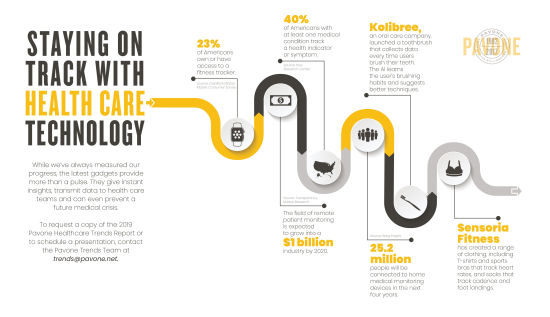
Why Americans Are Staying on Track with Innovative Healthcare Tech Tools

While we’ve always measured our progress, the latest gadgets provide more than a pulse — they give instant insights, transmit data to health care teams and can even prevent a future medical crisis.
Tracking one’s personal best has come a long way from the days of the manually operated stopwatch. Today, we strap on devices that tell us not only how far we’ve walked and how long it took us to get there, but also map our route, monitor our vitals, suggest how much energy we’ve burned, analyse our footsteps over time and much more!
In 2017, 23 percent of Americans owned or had access to a fitness tracker, according to Deloitte’s Global Mobile Consumer Survey. But we at Pavone see this as just the beginning of a tech-enhanced tracking trend that’s branching out to encompass many areas of health care. Consumers are moving beyond Fitbits to track an even wider variety of medical metrics.
That focus on tracking includes preventive medicine (an 'internal selfie' that monitors vitamin levels and cholesterol) and the tracking of serious health conditions (a spoon that monitors Parkinson’s). The field of remote patient monitoring is expected to grow into a $1 billion industry by 2020, according to Transparency Market Research.

WATCHING OUR WORLD
The mass adoption of the Fitbit has caused consumers to crave more ways to track an even wider variety of health metrics. We want data on everything from the quality of the air outside our apartments to intel on how well we’re brushing their teeth.
Clothes circuit: Tired of losing your Fitbit? Sensoria Fitness has created a range of clothing, including T-shirts and sports bras that track heart rates and socks that track cadence and foot landings. Data collected from the clothes can be paired with an app that uses artificial intelligence to customize workouts.
Brush league: Oral care company Kolibree launched a toothbrush that collects data every time users brush their teeth. The AI learns the user’s brushing habits and suggests better techniques. The company recently partnered with content providers — like the Rabbids video game — to create games to get people more engaged with brushing.
Truth or air: Many people are concerned about air quality and its impact on health. Flow from Plume Labs is a small mobile device that measures dust, exhaust fumes and chemicals in the air and then syncs with an app to display air quality. Plume Labs is taking preorders on its website.
Mapping asthma: About 25 million Americans suffer from asthma, according to the Centers for Disease Control and Prevention. Propeller Health claims that its new tracker can help reduce attacks by up to 75 percent. It attaches to an inhaler and works with an app to record when and where attacks happened. Physicians adjust asthma treatments based on the data.
MONITORING SERIOUS HEALTH ISSUES
New technology has emerged so patients can track a wider range of medical data, such as that associated with serious illnesses. More than 40 percent of Americans with at least one medical condition track a health indicator or symptom, according to the Pew Research Center.
Spoon-fed data: The GYENNO Spoon gathers data from hand tremors caused by diseases like Parkinson’s. The spoon uploads the tremor status and generates an algorithm to help improve performance of the handle. Information can be shared with doctors and researchers. (This product is currently only available in China.)
Vest opportunity: The FDA recently approved the CardioInsight™ Noninvasive 3D Mapping System, a single-use vest that allows heart patients to track serious cardiac conditions at home. The vest creates a cardiac “map” and sends the data to the health care provider. It can catch arrhythmias that could be missed by one-time ECG tests.
Got your back: Valedo tracks back problems through motion sensors on the lower back and one below the chin. An app tracks posture over time and provides recommendations of how to adjust through exercise. Valedo also offers games to help strengthen your back.
Nerve centre: An estimated 20 million Americans have some form of nerve damage, according to the National Institute of Neurological Disorders and Stroke. Neuropathy can often occur in the feet of elderly consumers. SurroSense RX® provides real-time information on the pressure on feet to avoid irreversible damage. The system notifies a smartwatch when dangerous pressure is detected.
REMOTE TRACKING
Health care providers are adopting technology so doctors can monitor patients while they go about their daily lives. The trend is being driven by elderly and chronically ill patients who want to remain in their homes as long as possible, but it is quickly spreading to other uses.
Remote patient monitoring is expected to grow into a $1 billion industry by 2020 — a 14 percent rise from 2014 — according to Transparency Market Research. About 25.2 million people will be connected to home medical monitoring devices in the next four years, Berg Insight predicts.
Not on 'Candid Camera': A network of wireless sensors is placed in residents’ living quarters that allows for remote monitoring. Residents continue their daily lives, with their privacy intact ,while data is sent to a server that learns to spot changes in their routine. Intel-GE Care Innovations®’ QuietCare® system uses predictive algorithms to help identify potential problems before they become urgent situations and provides information to caregivers in real time.
Baby monitors 2.0: Safe, wearable sensors monitor biometrics, including heart rates, blood oxygen levels and temperature. This trend has grown most rapidly in women dealing with difficult pregnancies. Bloomlife is a lightweight device that sticks to the belly to track and time contractions during the third trimester. Pregnant women can watch contractions in real time.
Fantastic voyage: Wireless sensors are implanted to provide continuous, personalised data on a wide range of conditions. To help improve diagnosis, Integrated Sensing Systems, Inc. created a miniature Wireless Intracranial Pressure Monitor that can recognize shunt failure. The device also eliminates some of the need for frequent CAT scans and MRIs.
No doubt about it, technology has answered our demands for smarter, more helpful input. What began with devices that simply recorded information (manually or sensed) has evolved to include analysing and predicting data - with even smarter and more predictive devices on the horizon.
The takeaway for healthcare brands is simple: If healthcare technology is evolving to meet consumer needs, your brand should evolve as well. That evolution can include finding ways to utilise the data that’s now at our fingertips or finding ways to deliver new insights current not available to your customers. Either way, today’s healthcare world is vastly different from just ten years ago and if you’re not looking at least a decade into the future, you run the risk of being left behind.
Darby Hughes is director of brand strategy at Pavone Marketing Group










